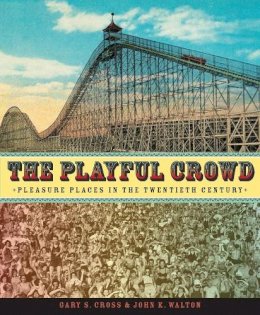
Stock image for illustration purposes only - book cover, edition or condition may vary.
The Playful Crowd: Pleasure Places in the Twentieth Century
Gary Cross
€ 98.65
FREE Delivery in Ireland
Description for The Playful Crowd: Pleasure Places in the Twentieth Century
Hardback. Explores playful crowds and the pursuit of pleasure in the twentieth century to offer a transatlantic perspective on changing ideas about leisure, class, and mass culture. This book examines the resorts' different fates as Coney Island has become a shadow of its former self while Blackpool continues to lure visitors and offer attractions. Num Pages: 352 pages, 1 black & white illustrations. BIC Classification: 3JJ; WTM. Category: (P) Professional & Vocational. Dimension: 216 x 178 x 24. Weight in Grams: 618.
During the first part of the twentieth century thousands of working-class New Yorkers flocked to Coney Island in search of a release from their workaday lives and the values of bourgeois society. On the other side of the Atlantic, British workers headed off to the beach resort of Blackpool for entertainment and relaxation. However, by the middle of the century, a new type of park began to emerge, providing well-ordered, squeaky-clean, and carefully orchestrated corporate entertainment. Contrasting the experiences of Coney Island and Blackpool with those of Disneyland and Beamish, Gary S. Cross and John K. Walton explore playful crowds and the pursuit of pleasure in the twentieth century to offer a transatlantic perspective on changing ideas about leisure, class, and mass culture. Blackpool and Coney Island were the definitive playgrounds of the industrial working class. Teeming crowds partook of a gritty vulgarity that offered a variety of pleasures and thrills from roller coaster rides and freak shows to dance halls and dioramas of exotic locales. Responding to the new money and mobility of the working class, the purveyors of Coney Island and Blackpool offered the playful crowd an "industrial saturnalia."Cross and Walton capture the sights and sounds of Blackpool and Coney Island and consider how these "Sodoms by the sea" flouted the social and cultural status quo. The authors also examine the resorts' very different fates as Coney Island has now become a mere shadow of its former self while Blackpool continues to lure visitors and offer new attractions. The authors also explore the experiences offered at Disneyland and Beamish, a heritage park that celebrates Britain's industrial and social history. While both parks borrowed elements from their predecessors, they also adapted to the longings and concerns of postwar consumer culture. Appealing to middle-class families, Disney provided crowds a chance to indulge in child-like innocence and a nostalgia for a simpler time. At Beamish, crowds gathered to find an escape from the fragmented and hedonistic life of modern society in a reconstructed realm of the past where local traditions and nature prevail.
Product Details
Publisher
Columbia University Press United States
Number of pages
352
Format
Hardback
Publication date
2005
Condition
New
Weight
618g
Number of Pages
352
Place of Publication
New York, United States
ISBN
9780231127240
SKU
V9780231127240
Shipping Time
Usually ships in 7 to 11 working days
Ref
99-1
About Gary Cross
Gary S. Cross is professor of history at Pennsylvania State University. He is the author of several titles, including An All-Consuming Century: Why Commercialism Won in Modern America (Columbia, 2000).John K. Walton is professor of social history at the University of Central Lancashire. His most recent book is The British Seaside: Holidays and Resorts in the Twentieth Century. Gary Cross is professor of history at Penn State and the author of An All-Consuming Century (CUP, 2000); Time and Money: The Making of Consumerist Modernity (Routledge, 1993; A Quest for Time: The Reduction of Work in Britain and France, 1840-1940 (University of California Press, 1989) and A Social History of Leisure since 1600 (Venture, 1990) Gary Cross is professor of history at Penn State and the author of An All-Consuming Century (CUP, 2000); Time and Money: The Making of Consumerist Modernity (Routledge, 1993; A Quest for Time: The Reduction of Work in Britain and France, 1840-1940 (University of California Press, 1989) and A Social History of Leisure since 1600 (Venture, 1990)
Reviews for The Playful Crowd: Pleasure Places in the Twentieth Century
Social history at its best... Essential. Choice This book, which is vividly and engagingly written, makes a major contribution to our knowledge and understanding of a cultural phenomenon. The Times Higher Education Supplement ...A fascinating account of the changing nature of the pleasure-seeking crowd in the US and Britain during the twentieth century.
Brad Beaven, University of Portsmouth Institute of Historical Research (UK) Engaging... fascinating... excellent... a model of collaborative scholarship, this book contributes much to the history of twentieth-century amusements.
Susan Currell The American Historical Review The Playful Crowd succeeds admirably, both as comparative history and as a study of popular leisure.
Scott C. Martin Journal of Social History A valuable book for students studying pleasure, leisure, and tourism.
Auvo Kostiainen Annals of Tourism Research The Playful Crowd does what few studies of leisure have attempted
compare tourism across time and space.
Thomas A. Chambers, Niagara University Winterthur Portfolio
Brad Beaven, University of Portsmouth Institute of Historical Research (UK) Engaging... fascinating... excellent... a model of collaborative scholarship, this book contributes much to the history of twentieth-century amusements.
Susan Currell The American Historical Review The Playful Crowd succeeds admirably, both as comparative history and as a study of popular leisure.
Scott C. Martin Journal of Social History A valuable book for students studying pleasure, leisure, and tourism.
Auvo Kostiainen Annals of Tourism Research The Playful Crowd does what few studies of leisure have attempted
compare tourism across time and space.
Thomas A. Chambers, Niagara University Winterthur Portfolio
